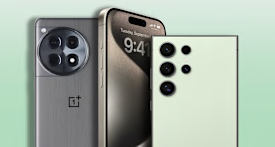
Cell Phone Service Buying Guide

Home & Tech Writer
If you haven’t looked for a new cell phone plan in a while, you may be paying a price for your loyalty—or inertia.
In a recent survey of nearly 52,000 Consumer Reports members, more than half of those who switched providers in the previous year said they saw a drop in their monthly bill. Many said they got more reliable coverage, a bigger data allowance, and better customer service, too.
If you’re considering a new plan, you might want a new phone as well. Many wireless carriers offer a free or discounted phone when you switch and trade in your old phone. You can check our cell phone buying guide and the best smartphones of the year (available to CR members) for assistance with that purchase.
Before you choose a plan, think about how much data you need. If you don’t require much because you’re typically connected to WiFi, you can save on a low-cost, low-data option. But if you stream a lot of music or movies over your cellular network, an unlimited plan may be a smarter move.
Provider: The First Choice You’ll Make
Consider Going Small
Generally speaking, consumers are more satisfied with service from smaller providers such as Consumer Cellular, Mint Mobile, or Ting. That’s because they tend to get quality reception, as much data as they need, and better customer service at a lower price, our survey found. Smaller carriers particularly benefit those with modest data needs because they have deeply discounted plans with lower data allotments.
If you need consistently high data speeds or prefer to receive customer support in person, one of the three larger carriers—AT&T, T-Mobile, or Verizon—may be a better fit. (Smaller providers tend to offer customer support only over the phone and online, allowing for more cost savings.) If you own a smartwatch or a tablet with a cellular connection, you might find better support for those devices at a larger carrier as well.
Confirm the Coverage
To confirm basic coverage in your area, especially if you’re looking for 5G, use the ZIP code maps and other resources provided on the carriers’ websites. But keep in mind that those references don’t take into account small dead zones in your neighborhood, so try to ask local friends how well their phones work in your area.
You should also make sure that you can cancel service and return any phone you purchased through the plan if a coverage problem crops up. For some carriers, the grace period is a brief 14 days. They might charge a restocking fee as well. If your phone supports the use of an eSIM card—a digital version of the SIM card you install into your device that connects you to a mobile carrier’s network—you can also try out a new carrier’s service before canceling your current one.
Count Your Phone Lines
That’s easy: That’s you plus your immediate family, and it’s okay to include people who don’t live with you.
Do the Mathon Data
Most providers offer unlimited plans (which means unlimited calling, texting, and data), but smaller providers tend to offer more limited-data options for less. You can get a sense of your monthly data consumption on your bill or through your online account.
The Lowdown on Data
How much data you burn through each month depends on your WiFi access (the more you’re away from it, the more cellular data you use), and how much you use a cellular connection to stream or download content, or play online games.
As mentioned, the smaller providers, which typically lease network space from the three big companies, offer more options for lower-data users. They will sell you bundles of gigabytes each month—from as low as 1 gigabyte or as high as around 20 gigabytes per month—but they also offer unlimited data plans. Conveniently, a few budget carriers, such as Google Fi and Ting, also offer certain flex plans where you can add data as needed or pay only for what you use, which can work well for low-data users.
AT&T, T-Mobile, and Verizon primarily offer different tiers of unlimited plans, with various data allotments for things like mobile hotspot data use when you employ your phone to access the internet on your computer at, say, a coffee shop. Keep in mind that the priciest plans offer more hotspot data than most of us would use—sometimes more than 30 gigabytes per month—so consider whether you’re paying too much for premium data offerings.
For families with multiple lines and at least one or two heavy data users, unlimited plans often offer a better deal, because shared buckets of data don’t go very far. With data allotment plans, you can forget about extras like free subscriptions to your favorite streaming services, too.
Cell Phone Carriers
Odds are you haven’t made changes to your cell service in years. That’s too bad. According to Consumer Reports’ most recent member survey, 58 percent of the people who had recently switched cell phone carriers said they saved money. Many of them also said they now enjoy more reliable coverage, faster data service, and better customer service. But only 7 percent of our members switched cell phone carriers in the year leading up to the survey—perhaps more should consider shopping around.
CR members can consult our article on the best and worst phone plan providers and our service provider ratings to see which companies offer the best value, customer support, cellular reception, and data service.
How to Pay for Your Phone
With the demise of the two-year contract, the cost of your phone is now clearly separated from the cost of your service. That leaves you with two solid options.
Pay Up Front, Keep Your Monthly Bills the Same
Not a bad choice if the phone model you’re eyeing isn’t too expensive. It also makes sense if credit problems prevent you from buying a phone in installments.
Pay for It Over Time
This is a great way to purchase a phone, especially if you have expensive tastes. The full retail price is usually divided into 24 or 36 monthly installments. After the loan term, you can scratch that fee from your bill. Plans differ by provider, so read the fine print before signing up.
If you buy the phone from your carrier, you have to commit to that carrier until the phone is paid off. If you leave, the balance is likely to be due immediately. Note that if you get a new phone at a discounted price from the carrier as part of a promotion or because you traded in an old phone, you might be required to pay the full price of the phone if you leave before the phone is paid off.
Once your phone is paid off, though, your wireless carrier is required to unlock the phone free so that you can switch to another network.
Retailers like the Apple Store and Samsung also allow you to finance your purchase. And they’ll sell you an unlocked phone, so you won’t be tied to a particular carrier.















